Superficial keratectomy can be used for symptomatic map-dot-fingerprint corneal dystrophy
The manual technique can be a less expensive alternative to using laser refractive technology.
 Thomas John |
Map-dot-fingerprint dystrophy of the cornea for the most part can be asymptomatic and may not require any treatment. Various treatment options are available for the management of symptomatic map-dot-fingerprint dystrophy, including diamond burr superficial keratectomy, alcohol delamination, and the use of laser modalities such as phototherapeutic keratectomy. Most of these techniques are largely effective, but some of them may be more expensive than others. Additionally, a clinician may not have easy access to or may not be currently using laser refractive technology.
In this column, I describe the surgical technique of manual superficial keratectomy for the management of symptomatic map-dot-fingerprint corneal dystrophy.
Patient history
A 40-year-old Caucasian man presented with blurred vision involving his right eye. He also complained of glare, halos and monocular diplopia in the right eye that interfered with his daily activities, depending on the lighting conditions. Clinical examination revealed bilateral map-dot-fingerprint corneal dystrophy that was more pronounced in his right eye (Figure 1).
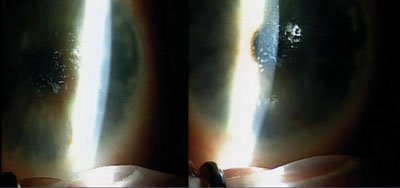 Figure 1. Slit lamp photographs showing significant corneal map-dot-fingerprint dystrophy affecting the visual axis. The corneal opacities overlie the pupillary region and extend to the peripheral cornea. Images: John T |
Surgical technique
Lidocaine jelly 2% was applied to the ocular surface (Figure 2). Attempts at removing the surface corneal layers with a Weck-Cel spear (Medtronic) were not very successful (Figure 3). Hence, a straight crescent blade (Alcon) was used to remove the corneal epithelium. The blade was held slanted to the corneal dome, such that the Bowman’s layer was not violated. The tangential motion of the blade on the corneal dome removed the surface corneal layers (Figure 4). Care was exercised to avoid any penetration into the Bowman’s layer. Starting from the central region of the cornea, the epithelium was removed in a circular manner (Figure 5). The surface corneal epithelial complex was removed, leaving an intact, smooth Bowman’s layer (Figure 6). The completed view of the superficial keratectomy is shown in Figure 7. There were no corneal opacities from the map-dot-fingerprint corneal dystrophy (Figure 7).
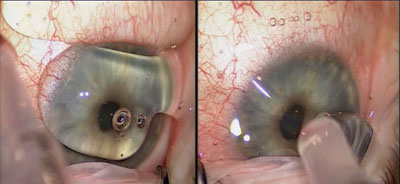 Figure 2. Lidocaine jelly 2% is applied to the ocular surface. |
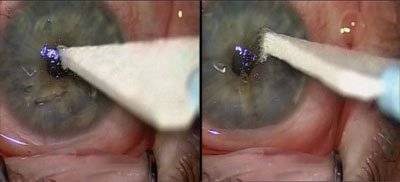 Figure 3. Attempts at removing the superficial layers of the cornea using a Weck-Cel spear are not successful. |
 Figure 4. A straight crescent blade is used to remove the corneal epithelium. The blade is held slanted to the corneal dome, such that the Bowman’s layer is not violated. |
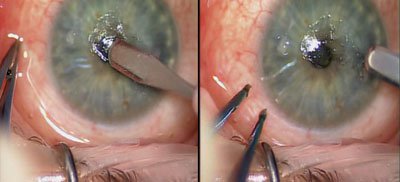 Figure 5. Starting from the central region of the cornea, the epithelium is removed in a circular manner. |
 Figure 6. The surface epithelial complex is removed with an intact Bowman’s layer. |
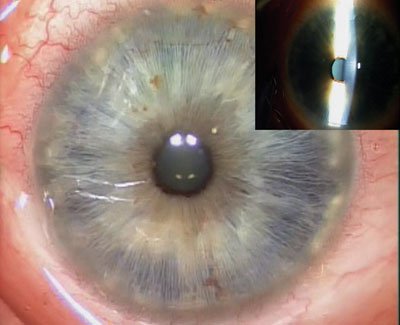 Figure 7. Completed view of superficial keratectomy. The cornea is devoid of all opacities from the map-dot-fingerprint corneal dystrophy. |
Follow-up
Postoperatively, an antibiotic and a steroid drop, such as Pred Forte 1% (prednisolone acetate, Allergan) four times a day and Besivance (besifloxacin, Bausch + Lomb) three times a day, were used until re-epithelialization was complete. A bandage soft contact lens added to patient comfort during the surface healing.
Surgical pearls
The epithelial complex is relatively well-attached to the underlying cornea in the absence of recurrent erosion. Hence, a Weck-Cel sponge alone will not usually remove the surface corneal layers. Use of a straight crescent blade will facilitate the removal of the outer corneal layers.
It is important not to damage the Bowman’s layer of the cornea. An intact, smooth Bowman’s layer will facilitate re-epithelialization without secondary scarring.
References:
- Mencucci R, Paladini I, Brahimi B, Menchini U, Dua HS, Romagnoli P. Alcohol delamination in the treatment of recurrent corneal erosion: an electron microscopic study. Br J Ophthalmol. 2010;94(7):933-939.
- Pogorelov P, Langenbucher A, Kruse F, Seitz B. Long-term results of phototherapeutic keratectomy for corneal map-dot-fingerprint dystrophy (Cogan-Guerry). Cornea. 2006;25(7):774-777.
- Seitz B, Lisch W. Stage-related therapy of corneal dystrophies. Dev Ophthalmol. 2011;48:116-153.
- Soong HK, Farjo Q, Meyer RF, Sugar A. Diamond burr superficial keratectomy for recurrent corneal erosions. Br J Ophthalmol. 2002;86(3):296-298.
- Thomas John, MD, is a clinical associate professor at Loyola University at Chicago and is in private practice in Oak Brook, Tinley Park and Oak Lawn, Ill. He can be reached at 708-429-2223; fax: 708-429-2226; e-mail: tjcornea@gmail.com.
- Disclosure: Dr. John has no relevant financial disclosures.

